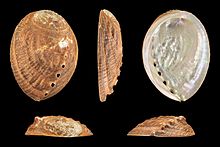Haliotis gigantea Contents Description Distribution References External links Navigation menu""Siebold's abalone (Nordotis gigantea), disk abalone (Nrodotis discus), and red sea cucumber (Holothroidea) in Fukuoka Prefecture""H.A. Pilsbry (1890) Manual of Conchology XII; Academy of Natural Sciences, Philadelphia, 1890abstract"Haliotis (Haliotis) gigantea"311025543577531053635110484893774383745367891
HaliotisGastropods described in 1791
speciessea snailmarinegastropodmolluskHaliotidaeabalonesPhilipp Franz von SieboldspirenacrecopepodectoparasiticJapanKorea
Haliotis gigantea | |
|---|---|
 | |
Haliotis gigantea var. sieboldii | |
Scientific classification | |
| Kingdom: | Animalia |
| Phylum: | Mollusca |
| Class: | Gastropoda |
Clade: | Vetigastropoda |
| Family: | Haliotidae |
| Genus: | Haliotis |
| Species: | H. gigantea |
Binomial name | |
Haliotis gigantea Gmelin, 1791 | |
Synonyms | |
| |
Haliotis gigantea, common name the giant abalone, is a species of sea snail, a marine gastropod mollusk in the family Haliotidae, the abalones. It is known as Siebold's Abalone, after Philipp Franz von Siebold.[1][2]
Contents
1 Description
2 Distribution
3 References
4 External links
Description
The size of the shell varies between 80 mm and 200 mm. "The very large shell has a rounded-oval, quite convex shape. The distance of the apex measures from the margin between one-ninth and one-tenth the length of the shell. The surface of the shell shows coarse, low, unequal spiral cords and broad wave-like undulations. The typical form of this shell is one of the largest in the genus. It has a rounded-oval outline. The back of the shell is quite convex and highest in the middle. It is solid but not very thick,. The coloration is reddish-brown, radiately streaked more or less with chocolate and green. The spiral cords are low but strong. And there are irregular but very strong wavelike obliquely radiating folds above. The four open perforations are situated in high tubercles upon a strong dorsal angle, below which the left side slopes steeply to the columellar margin. This slope has low spiral cords, waved or festooned below the row of the holes, and it has also an obtuse ridge parallel with that row, not far below it. The spire is very small, quite low. Inside there are shallow spiral sulci and indentations at the positions of the cords and waves of the exterior. The nacre is light colored or silvery, to a high degree iridescent, reflections of emerald green and red predominating. The muscle attachment is smooth, but its posterior and lateral outlines are marked by a rugose line. The columellar plate is wide, its face concave, sloping inward." [3]
The copepod Panaietis haliotis Yamaguti, 1936 is ectoparasitic on this species.
Distribution
H. gigantea is endemic to the waters off Japan [4] and Korea.[5]
References
^ ""Siebold's abalone (Nordotis gigantea), disk abalone (Nrodotis discus), and red sea cucumber (Holothroidea) in Fukuoka Prefecture"". JST: Science Links Japan. 2009. Retrieved February 16, 2011..mw-parser-output cite.citationfont-style:inherit.mw-parser-output .citation qquotes:"""""""'""'".mw-parser-output .citation .cs1-lock-free abackground:url("//upload.wikimedia.org/wikipedia/commons/thumb/6/65/Lock-green.svg/9px-Lock-green.svg.png")no-repeat;background-position:right .1em center.mw-parser-output .citation .cs1-lock-limited a,.mw-parser-output .citation .cs1-lock-registration abackground:url("//upload.wikimedia.org/wikipedia/commons/thumb/d/d6/Lock-gray-alt-2.svg/9px-Lock-gray-alt-2.svg.png")no-repeat;background-position:right .1em center.mw-parser-output .citation .cs1-lock-subscription abackground:url("//upload.wikimedia.org/wikipedia/commons/thumb/a/aa/Lock-red-alt-2.svg/9px-Lock-red-alt-2.svg.png")no-repeat;background-position:right .1em center.mw-parser-output .cs1-subscription,.mw-parser-output .cs1-registrationcolor:#555.mw-parser-output .cs1-subscription span,.mw-parser-output .cs1-registration spanborder-bottom:1px dotted;cursor:help.mw-parser-output .cs1-ws-icon abackground:url("//upload.wikimedia.org/wikipedia/commons/thumb/4/4c/Wikisource-logo.svg/12px-Wikisource-logo.svg.png")no-repeat;background-position:right .1em center.mw-parser-output code.cs1-codecolor:inherit;background:inherit;border:inherit;padding:inherit.mw-parser-output .cs1-hidden-errordisplay:none;font-size:100%.mw-parser-output .cs1-visible-errorfont-size:100%.mw-parser-output .cs1-maintdisplay:none;color:#33aa33;margin-left:0.3em.mw-parser-output .cs1-subscription,.mw-parser-output .cs1-registration,.mw-parser-output .cs1-formatfont-size:95%.mw-parser-output .cs1-kern-left,.mw-parser-output .cs1-kern-wl-leftpadding-left:0.2em.mw-parser-output .cs1-kern-right,.mw-parser-output .cs1-kern-wl-rightpadding-right:0.2em
^ Bouchet, P. (2012). Haliotis gigantea Gmelin, 1791. Accessed through: World Register of Marine Species at http://www.marinespecies.org/aphia.php?p=taxdetails&id=367891 on 2013-02-06
^ H.A. Pilsbry (1890) Manual of Conchology XII; Academy of Natural Sciences, Philadelphia, 1890
^ Oliver, A.P.H. (2004). Guide to Seashells of the World. Buffalo: Firefly Books. 22.
^ (in Japanese) Uichida K. & Yamamoto T. (1942). "朝鮮近海に於けるアハビの分布 On the distribution of Haliotis species in the Korean waters". ヴヰナス The Venus 11(4): 119-125. abstract
- Geiger D.L. & Poppe G.T. (2000). A Conchological Iconography: The family Haliotidae. Conchbooks, Hackenheim Germany. 135pp 83pls
- Geiger D.L. & Owen B. (2012) Abalone: Worldwide Haliotidae. Hackenheim: Conchbooks. viii + 361 pp. page(s): 93
External links
"Haliotis (Haliotis) gigantea". Gastropods.com. Retrieved 16 January 2019.
| Wikimedia Commons has media related to Haliotis gigantea. |
Gastropods described in 1791, HaliotisUncategorized